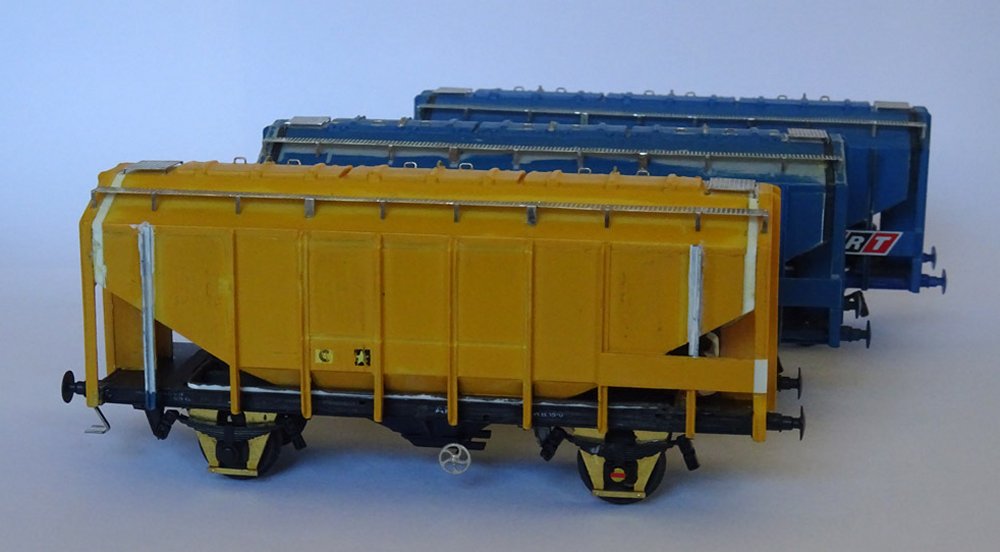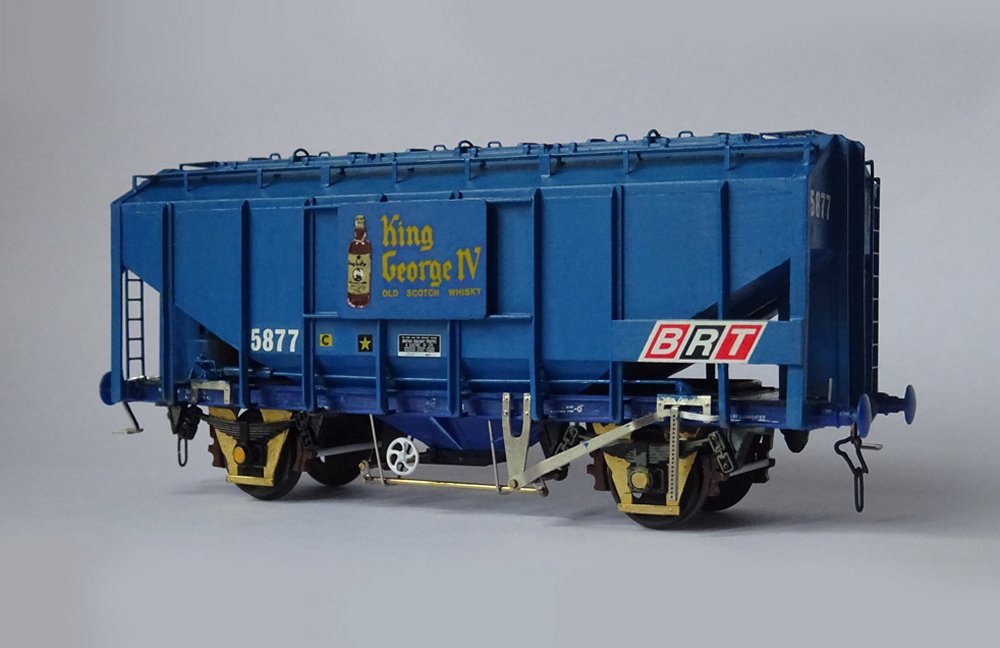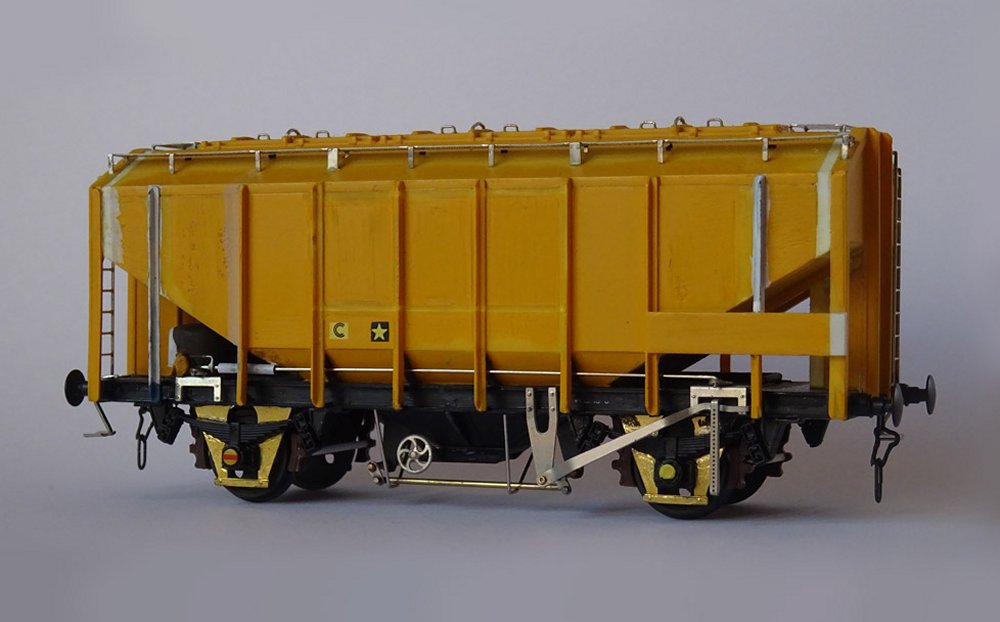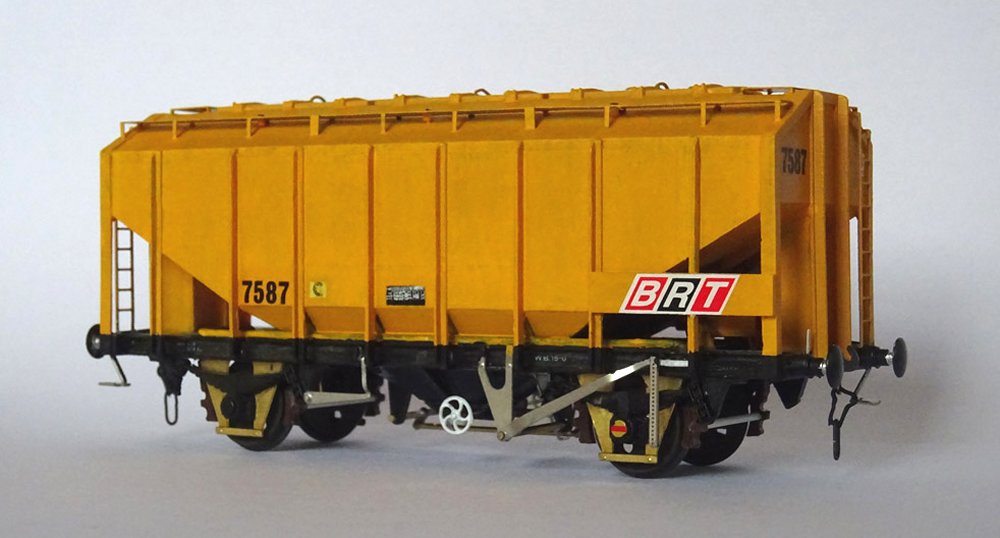*****************************************************************************************************************************************************************
Detailing 35T BRT Grain Wagons - Pete Johnson
*****************************************************************************************************************************************************************

A project dating back to January 2017 was to detail some 35 ton BRT Grain Hoppers to
a better standard. Comparison of the Bachmann model of the early (Mk1) type with
the BR dimensional diagram and photos of the early style wagon show it to be about 3mm under-length,
mostly taken from near the ends. The models have been stripped down and had the ends cut away
with a razor saw to allow the length to be increased.

A detail view showing the (black) plastic additions bonded to the end of the hopper tub.

With the glue completely dried, the added plastic is smoothed to the profile of the tub.

With the ends refitted the hopper tub becomes scale length. The repositioned side
stanchions near the ends have still to be fitted, and the roof has been smoothed ready for
etched walkways to be added.

The Lima model of the later (Mk2) BRT hopper style is good for length, but suffers from
inaccurate rendering of the poster boards. To correct this, the centre section has been cut
out and replaced with 1.5mm thick plastic, the central stanchion has then been added.

For both the Mk1 and Mk2 wagons the underframe has been based on the
Lima moulding which is the correct length and has nicely rendered
buffers. To maintain the ‘open frame’ look the MJT w-irons have had the main deck cut away
after first being securely soldered in the corners.

Re-uniting the body tubs and underframes begins to make the wagons look the part,
although there is still a long way to go. 'Haig’ has the later pattern (Lima) bodywork
style, but has been fitted with chain-hung springing salvaged from the Bachmann underframes
to portray the ‘as-built’ condition of this type.

In contrast, this example is the Mk1 style bodywork, but fitted with the later
pedestal type suspension of the Lima model as retro-fitted to most of the fleet in the mid-1970s.

This detail view shows the thinned stanchions of the Bachmann tub bonded to the ‘C’ shape solebar
joiners – each individually cut and fitted from a bonded channel section made from three pieces
of 0,5mm styrene strip. The vacuum pipe has also been added using styrene rod.

The detailing etches for the 35t Blue Grain hoppers are shown. These were my first
attempt at etching artwork and worked out well, with PPD Ltd of Scotland completing
the process. In this view the roof walkways, in both Mk1 and Mk2 styles, are shown.

A second sheet, in thicker nickel silver, contains the brake gear and ladders. These
are also to two patterns to suit the early and late version of the wagon design.

Many of the etched parts need to be formed and soldered before fitting.
This view shows the basic ‘jig’ for holding the brake lever pieces during assembly.

An example of a completed lever after soldering, on this one the ability to model the
lever in the dropped position has been used. A 0.3mm brass wire has still to be added in the
missing bolt position, this then being fixed in a hole drilled into the solebar to secure
the V-hanger to the underframe.

‘VAT 69’ – an early type wagon, shows the etched brake lever system in position.

‘Good old Johnnie Walker’ displays the brake rigging of the other side. A Triang ‘00’
gauge wagon of this branding, received as a Christmas present when I was about 10, planted the
seed for this project of some 45 years later!

‘Haig’ shows the slightly different etched parts as fitted on the Mk2 style wagon.

A close-up view showing the etched walkway details in position, the challenge now is
to get some paint onto these without blocking all the holes!

During 2021 a further batch of five Mk1 35t BRT grain wagons was made to enlarge the fleet.
The models will be finished as four blue poster-board examples, and one ex-Maltsters Association yellow wagon.

A ‘Johnnie Walker’ early type wagon is shown after fitting of the etched roof walkways and ladders.

With the detailing work complete this Mk1 wagon, with White Horse posters, is ready for paint.

VAT 69, fleet number 5848, is shown in ex-works condition. The blue colour
used was blended from Revell Gloss 52 and Humbrol Matt 109. Fox Transfers came up trumps
after a request for a suitable re-sizing of one of their existing sheets to provide the
block-style numerals. The sheet has now been added to their range as F4122/2, catering for
both the blue and yellow (black numbering) liveried fleets of these wagons.

Within the second batch of models a new poster has been added to the fleet using
old Trix boards. King George IV branded 5877 is pictured ready for final weathering.

Lima-based Mk2 style wagon 6134 Haig is also shown ready for weathering.

The thinly applied blue top-coat left the walkway holes clear – much to my relief.

The poster-board grains have been quite lightly weathered as they model their condition when only a
few years old, and may have been subject to wash-downs to judge by pictures from the early
years. White Horse fleet number 5821 is shown ready for service.

Johnnie Walker 6112 is shown at the same stage. The grime-tinted Humbrol enamel varnish used
for the weathering dried completely matt giving a perfect finish.

…even after weathering the walkway holes did not block!!

Broadside portrait of VAT 69 fleet number 5848 in finished condition…..
worth all the effort over the past few months.

The Blue Grains have featured in both Scottish and East Anglian sequences on Canada Street, portraying
the two ends of their regular route during the latter years of the 1960s.

A further five Blue Grains have been finished in the condition they appeared in the late 1970s. The real 7678
was rebuilt into the pedestal suspension, with its poster board fixings removed, during
the summer of 1974. The model is pictured after the blue top coat has been applied.

Although most of the fleet were blue, the Maltsters Association wagons were bright yellow.
One survivor from this fleet has been modelled and is shown ready for painting. These wagons never received the pedestal suspension retro-fit.

BRT 7553 is a Mk1 wagon based on the Bachmann model. By the late 1970s the
whole fleet had been renumbered into the 7500-7799 range, and some – as here – had the
number applied within a datapanel format.

The colourful yellow grain hopper, fleet number 7587, is shown ready for weathering.

Mk1 wagon 7504, in a fairly typical dirty condition for these wagons
in the final years of the blue livery.

The final member of the group is 7746, which survived into the early 1980s still in
blue with a set of poster board fixings. Photographs show small strings of these wagons running on the Birkenhead dock
lines into the early 80s.

The yellow hopper has been heavily weathered, as it would have looked in the late-1970s, only the
cleaned patches around the fleet numbers reveal the true colours.

A pair of the weathered blue hoppers is shown during the Birkenhead 1979 sequence on the layout.
*****************************************************************************************************************************************************************









































